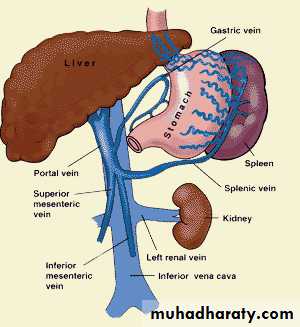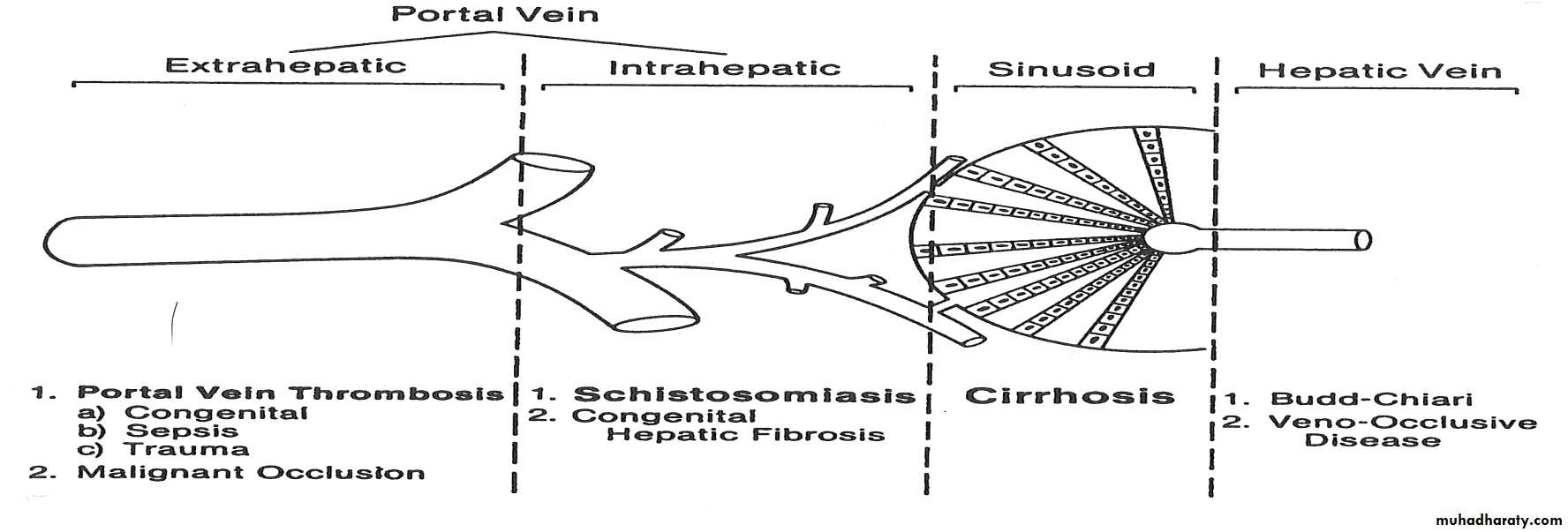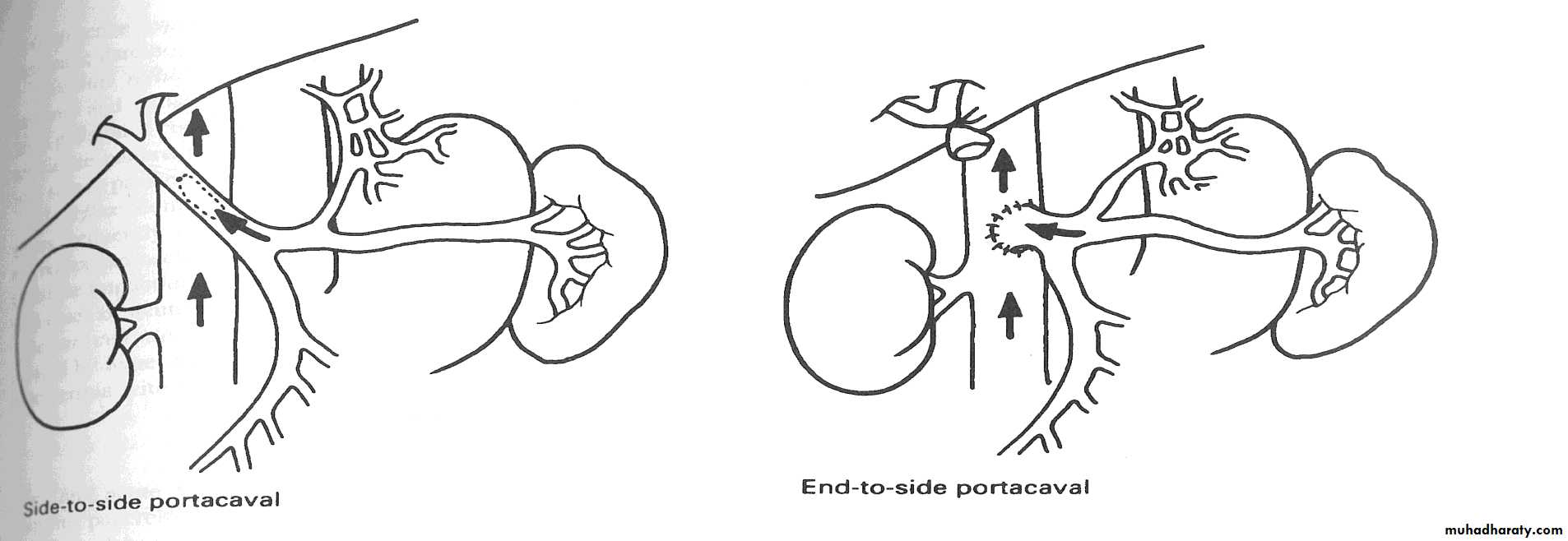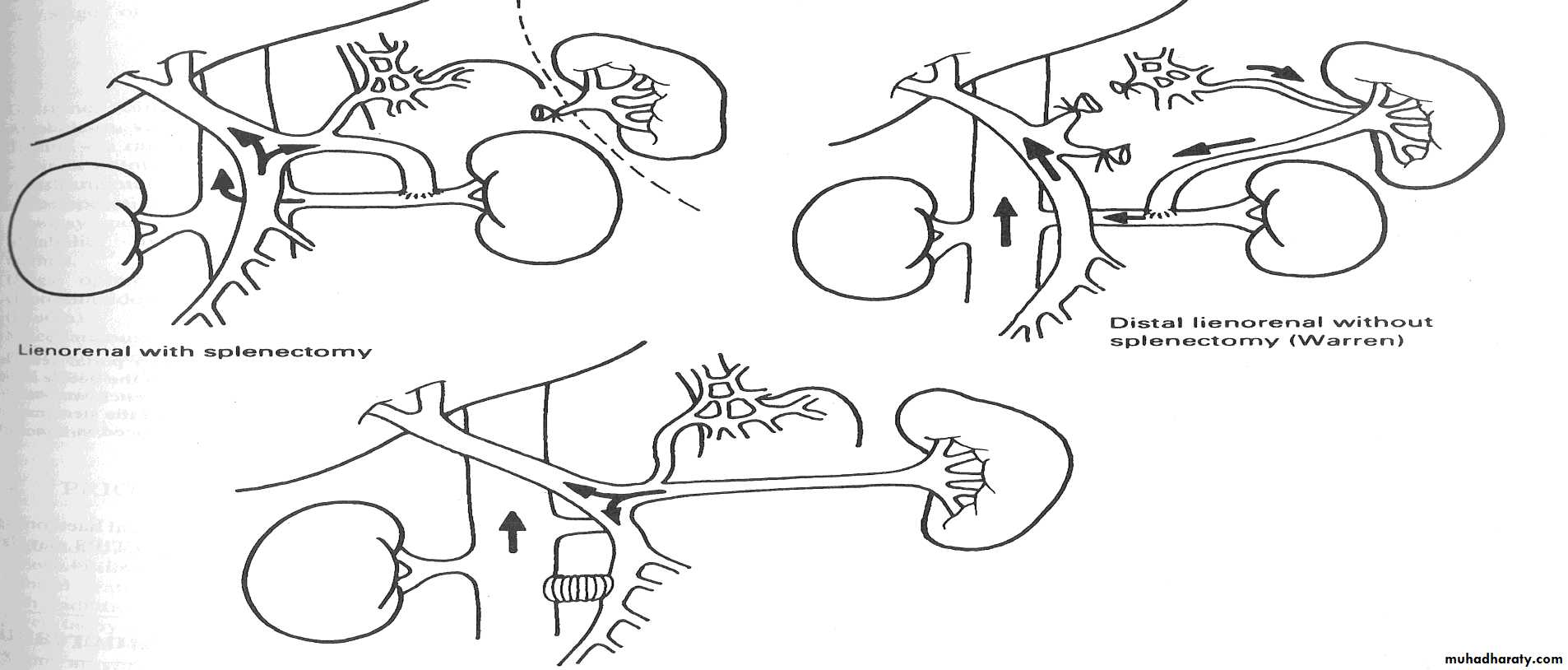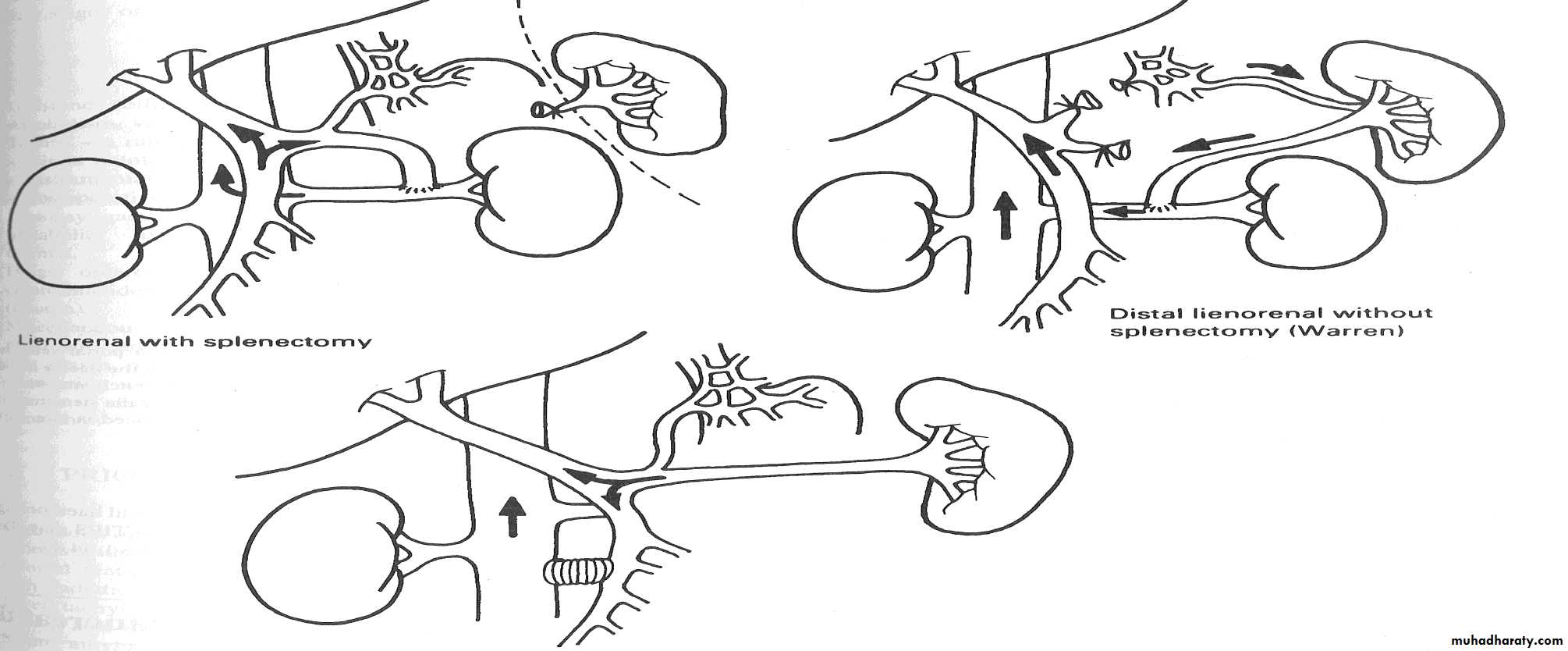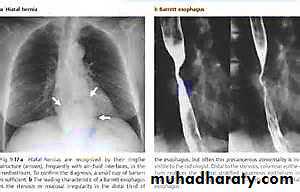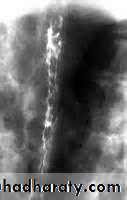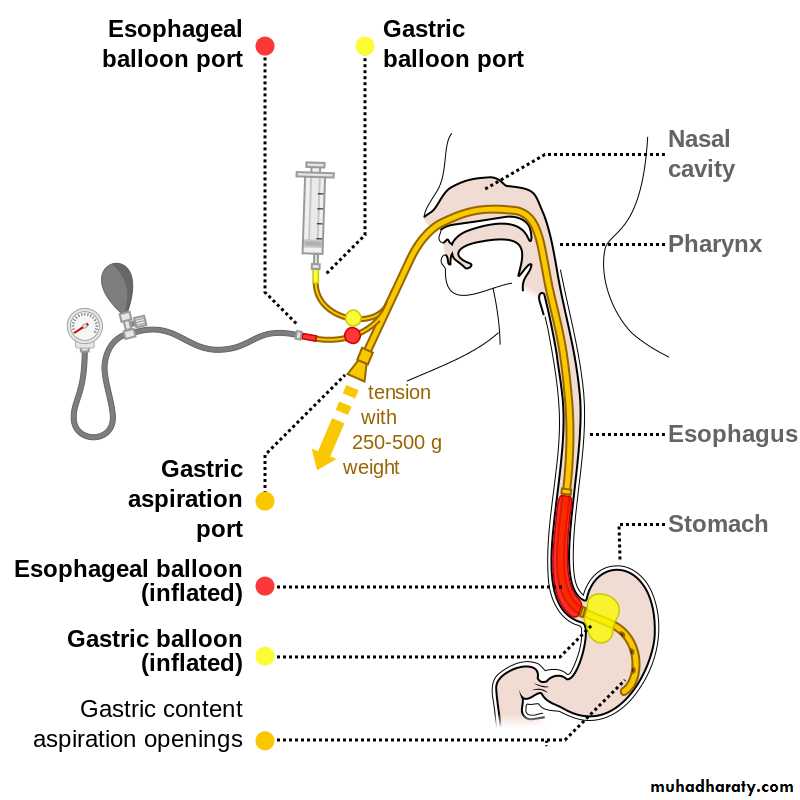Portal Hypertension
Dr. Basim RassamAl-Madena copy
1
Portal Hypertension
Normal portal venous pressure is 80 -120 mm H2O and depends on splanchnicblood flow, resistance to outflow from the liver and pressure in the Inferior vena
cava. In portal hypertension it reaches 400 mm H2O or more.
Bleeding from oesophageal varices starts when portal pressure exceeds
250 – 300 mm H2O. The portal vein is formed of two main vessels- the
Superior mesentieric and splenic veins.
It has no valves .As a result of portal
hypertension, extrahepatic portasystemic
anastomotic channels become engorged and
dilated ( i.e. oesphageal varices
with profuse painless heamatmesis, caput
medusae around umbilicus and
haemorrhoids). Hypersplenisim with
pancytopaenia, stasis in the portal
circulation with portal vein thrombosis and
infarction of the intestine, as well as
ascites , also results.
• . Prehepatic presinusoidal (liver is normal) include umbilical sepsis (neonatal), clotting diathesis (polycythaemia), malignant portal vein obstruction and idiopathic causes.
• . Intrahepatic presinusoidal (liver is diseased) include schistosomiasis, congenital hepatic fibrosis, sarcoidosis and liver intoxication.
• . Intrahepatic postsinusoidal group includes cirrhosis.
• . Posthepatic postsinusoidal include hepatic vein obstruction (Budd-Chiari syndrome) and constrictive pericarditis.
• Schistosomiasis and cirrhosis are the commonest causes of portal hypertension worl-wide.
3
Causes of Portal Hypertension
Al-Madena copy
There are four main areas of portosystemic anastomosis that become developed in portal obstruction. These are:Oesophageal varices and resulting gastrointestinal haemorrhage are the most serious complication of portal hypertension.
Splenomegaly occurs because of:
Ascites is due to a combination of:
4
Al-Madena copy
↑ Aldosterone activity with sodium retention
↑ Lymphatic pressure in the cirrhotic liver resulting in lymph transudation.
Clinical features of portal hypertension
Because of its range of effects, portal hypertension can present in many ways:Haemorrhage from bleeding oesphageal varices or haemorrhoids
With signs hepatic failure: jaundice; CNS effects; stigmata of liver disease
A cause of splenomegaly
A cause of hepatomegaly
Because of its catastrophic effect, haemorrhage from bleeding oesphageal varices is the most significant surgical presentation of portal hypertension.
Haemorrhage from oesophageal varices
Oesophageal varices account from 50% of deaths from upper gastrointestinal bleeding, although they cause only 10% of cases. Whilst the patient is being resuscitated, certain investigations should take place- others should be delayed until the patient’s condition stabilizes (see the shaded box below).5
Al-Madena copy
Diagnosis and assessment of portal hypertension
Liver function tests; chest X-ray; barium swallow (soap-bubble appearance of varices); barium meal; i.v. urography to evaluate left renal function (for lienorenal shunt); splenoportography and ultrasound (may show patent or obstructed portal vein); transhepatic venography and endoscopy especially in emergency bleeding to confirm the site of bleeding from chronic peptic ulcer or erosive gastritis which may account for %40 of misdiagnosed bleeding varices. Peptic ulcer is more common in cirrhotics and the presence of varices does not necessarily mean that they are source of upper gastrointestinal tract bleeding. The severity of liver disease is graded according to Child’s classification into A, B and C and modified into a flexible system using points.Serum bilirubin
(mg/100ml) < 2 (1), 2-3 (2), > 3 (3)(μmol/1) < 34 (1), 34-51 (2), >51 (3)
Serum albumin
(g/100ml) > 3.5 (1), 3-3.5 (2), <3 (3)
Prothrombin time
(seconds prolonged) <2 (1), 3-5 (2), >5 (3)
6
Al-Madena copy
Ascites None (1), Mild/moderate (2),
Gross (3)
Encephalopathy None (1), Minimal (2),
Moderate/severe (3)
The added points are classified as follows:
A= 5-7 points
B= 8-9 points
C= 10-15 points
A liver biopsy is essential and liver scan may be required to exclude hepatomas. The ideal patient for a shunt operation should be under 45 years of age, category A or B, with inactive liver disease and should look and feel well.
The four important effects of portal hypertension are:
Development of a collateral portosystemic circulationSplenomegaly
Ascites
Hepatic failure and its sequelae.
7
Al-Madena copy
The management should be carried out in high-dependency units with specialized teams. The principles are:
Control of variceal haemorrahge
Immediate resuscitation takes priority. The airway should be protected. Central venous access is often indicated. Blood, fresh frozen plasma and platelets are usually needed. Catheterization to monitor urine output. Over-expansion of the circulation may cause a dangerous increase in portal venous pressure. Prevention od complication or the early recognition and treatment of these is important.
8
Al-Madena copy
Complications of vericeal haemorrhage
Drug treatment of oesophageal varicesSomatostation is a hormone that reduces splanchnic and hepatic flow. Octreotide and lanreotide are longer-acting synthetic analogues of somatostatin. Vasopressin causes generalized vasoconstriction but its use is controversial. It is given in combination with glyceryltrinitrate under close cardiac monitoring. Terlipressin is an analogue of vasopressin which has a longer action and fewer systemic effects.
Ballon tamonade
Insertion of a double-ballooned Sengstaken-Blakemore or Minnisota tube into the oesophagus controls variceal bleeding temporarily by direct compression at the bleeding site. Use of balloon tamponade is recommended in:It should not be used in patients with a large hiatus hernia.
9
Al-Madena copy
Sclerotherapy of varices
Injecting sclerosant, such as ethanolamine, into bleeding varices is usually undertaken at the initial emergency endoscopy to control acute bleeding. Successful in 70-90% of cases, and may be repeated the following week to prevent re-bleeding. If two attempts of sclerotherapy fail, a more major intervention is indicated. Complications include:Fever
Retrosternal discomfort
Dysphagia
Ulceration
Stricture
Local perforation
Variceal banding
Banding produces better control of bleeding than sclerotherapy with lower morbidity and reduced re-bleeding. Not as suitable for the acutely bleeding patient, due to technical limitations. Banding is therefore recommended for second or subsequent endoscopy sessions to eradicate varices initially treated by sclerotherapy.
10
Al-Madena copy
Intrahepatic shunt
Trans-jagular intrahepatic porto-systemic shunt (TIPSS) is a radiological technique for creating a porto-systemic shunt via the trans-jagular route.Indications for TIPSS
The principle is to reduce the portal pressure gradient by short circuiting the liver. TIPSS is contraindicated in:
11
Al-Madena copy
Extrahepatic shunt
In long-term elective treatment, extrahepatic shunt or oesophageal transection are the alternatives to repeated sclerotherapy. The aim of extrahepatic shunt is to decompress the whole or part of the portal venous circulation. These shunts require a surgical procedure and are indicated in patients with failed endoscopic treatment. The three main extrahepatic shunts are:12
Al-Madena copy
Mesocaval graft interpostion
Al-Madena copy13
Oesophageal transection
The aim of oesophageal transection is to interrupt the gastric oesophageal porto-systemic anastomosis. Early oesophageal transection has compared favourably with injection sclerotherapy, but it requires a laparotomy and disseration in the presence of established portal hypertension and opening of the stomach, all of which may be hazardous in the acutely bleeding patient.Anterior gastrotomy
Stabling gun passed up into the oesophagus
Vagus nerve identified and excluded
Lower oesophageal wall tied into stapling line
Gun fired to transect and re-anastomose the oesphagus simultaneously
Problems include:
Bleeding gastric varices require further devascularizationMay be more hazardous than simple partial shunt
Chances od sepsis are increased by opening stomach
Recurrent bleeding is more likely than with shunts
14
Indication for elective surgery in portal hypertension
Bleeding oesophageal varices (once they have bled they will bleed again) is an
absolute indication. Hypersplenism and ascites are relative indications.
Al-Madena copy
Liver transplantationLiver transplantation may be the preferable option for intractable portal hypertension. It is not suitable in cases of pre-hepatic obstruction with good liver function or in cases with a persisting underlying cause.
15
Al-Madena copy
Thank you
Al-Madena copy16
17
Al-Madena copy
18
Al-Madena copy
19Al-Madena copy

